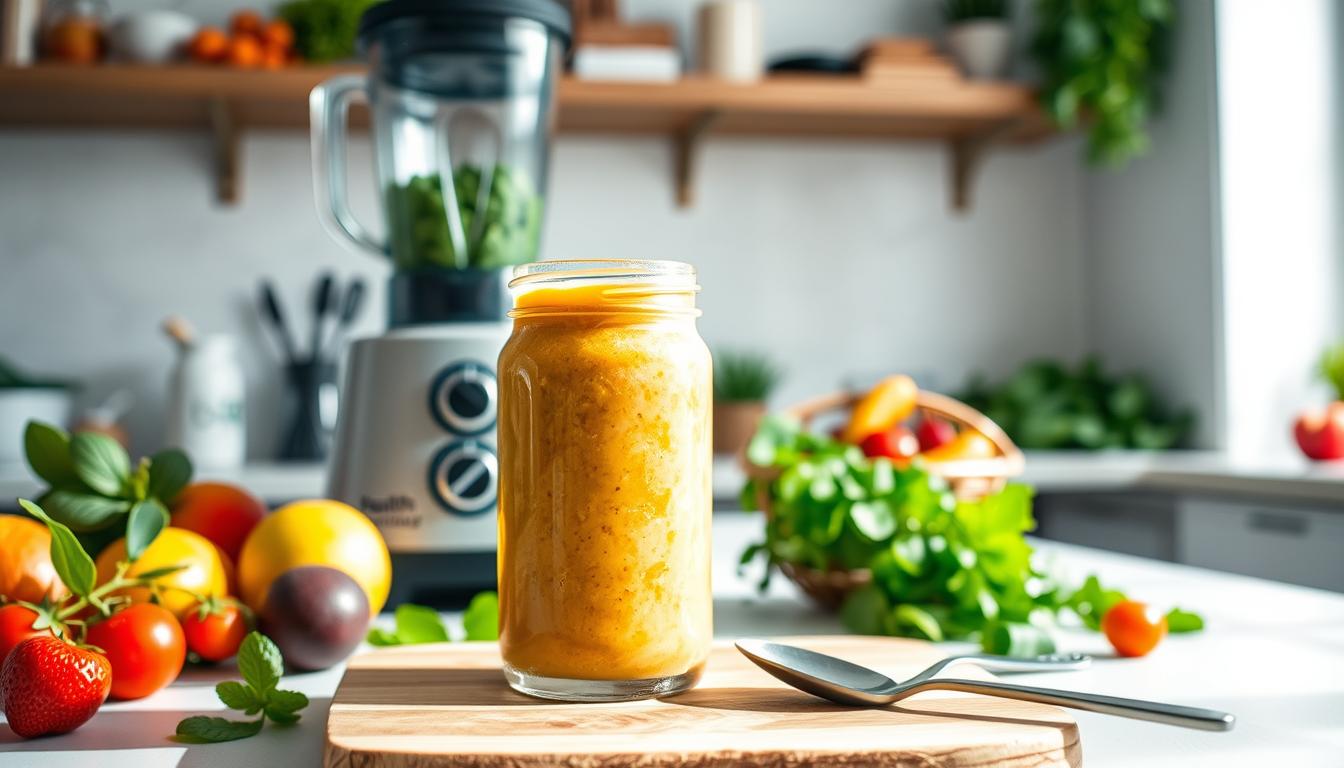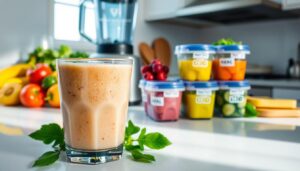Can You Freeze Smoothies for Later is the practical question many vegan cooks ask when planning quick breakfasts and packed lunches.
Batch prep saves time. A simple vegan method helps keep flavor bright and texture creamy. Use tempered-glass jars, leave about 1/2 inch headspace, seal tightly, and freeze up to two months.
Transfer a jar to the fridge the night before or thaw at room temperature in the morning. Smoothies can double as an ice pack and be lunch-ready by midday. Reblend and thin with a splash of juice if needed to restore texture and flavor.
Ready to cut morning prep? Try our smoothie generator to build custom vegan recipes and ingredient combos in seconds: https://healthconservatory.com/smoothie-generator
Key Takeaways
- Can You Freeze Smoothies for Later gives a vegan-first plan to save time and preserve taste.
- Use tempered-glass jars and leave headspace to avoid cracks.
- Freeze labeled portions on the weekend for quick morning or lunchbox options.
- Thaw in the fridge overnight or at room temperature, then reblend with juice if needed.
- Choose ingredients that hold texture: frozen fruit, greens, plant protein, and a little juice.
Can You Freeze Smoothies for Later: What You Need to Know First
A simple idea helps protect flavor: keep air away. To best preserve a smoothie, limit air exposure to slow oxidation. Less air keeps nutrients, color, and taste closer to fresh.
Choose airtight containers with screw-on lids. This reduces oxidation in both refrigerator and freezer storage. Tempered glass works well for vegans who avoid plastic; leave about 1/2 inch headspace so the container won’t crack when the contents expand.
Short-term, the refrigerator holds smoothies for 24–48 hours. For longer storage, the freezer is the better way to keep taste and nutrition up to three months when sealed properly.
- Blend well and pick ingredients that freeze cleanly to avoid gritty texture.
- Label each container with flavor and date to track time and rotate food safely.
- Start with one or two flavors to compare refrigerator vs freezer results.
| Storage | Best Time | Container Tips | Key Benefit |
|---|---|---|---|
| Refrigerator | 24–48 hours | Screw-on lids, minimal air | Quick access, fresh flavor |
| Freezer | Up to 3 months | Tempered glass, 1/2″ headspace | Long-term nutrient protection |
| General | Label & rotate | Airtight containers recommended | Less waste, consistent taste |
How Long Smoothies Last: Fridge vs. Freezer Time and Temperature
Shelf life for a fruit-and-green blend shifts dramatically between refrigerator storage and deep-freeze.
In the refrigerator, most smoothies keep peak quality about 24–48 hours. To limit oxidation, minimize headspace and use an airtight container so less air touches the surface.
Freezer storage and months of shelf life
In the freezer, a sealed jar or bottle preserves taste for up to 2–3 months when the temperature stays steady. Colder, consistent temperature reduces ice formation and preserves color.
Signs a batch is past its prime
Watch for heavy separation, a sour or dull smell, or ice crystals throughout the cup. Those are clear signs the recipe is no longer at its best.
- Label the container with date and flavor to rotate older batches first.
- Avoid frequent freezer door openings to cut temperature swings and extra ice.
- After thawing, briefly reblend the drink to restore creaminess and integrate settled fruit fibers.
The Best Containers to Store Smoothies and Reduce Oxidation
Choosing the proper container reduces oxidation and keeps color and flavor bright. This matters most when prepping batches for breakfast or lunch on busy days. Pick options that cut air contact and stand up to cold temperatures.
Tempered glass jars and bottles
Tempered glass gives a clean taste and resists thermal shock. Leave about 1/2 inch headspace to allow expansion and avoid cracks. Let glass rest a few minutes at room temperature before washing with hot water to reduce stress.
Plastic and silicone options
BPA-free plastic or silicone works well when weight matters. These container types are freezer-safe and lunchbox-ready. Slim bottles fit bags and keep a cold pack company during commute.
Headspace, lids, and air
Screw-on lids seal better than press-on tops and slow oxidation by limiting air contact. Wipe rims clean so the lid seats properly and won’t leak in a lunchbox.
Portable breakfast and lunch ideas
- Freeze upright, then store flat once solid to save space.
- Mark the top or side with date and flavor for fast rotation.
- Use a frozen jar as an ice pack and move to the fridge by midday to thaw gently.
Step-by-Step: The Easiest Way to Freeze Vegan Smoothies
A tidy routine—blend, seal, label—keeps flavors bright and mornings simple. Follow these steps to make grab-and-go vegan breakfasts in minutes.
Blend your recipe
Start with fruits, leafy greens, plant milk, and add-ins. Use a high-speed blender to reduce grit so texture freezes and thaws evenly.
Pour and seal
Fill jars or bottles, leaving about 1/2 inch headspace. Tighten the lid to avoid leaks and pressure cracks in the cold.
Freeze smart
- Freeze upright for the first few minutes, then lay flat to save space and speed chilling.
- Label each container with flavor and batch date so you can grab the right one each day.
- For single serves, freeze smoothie cubes in ice trays, then pack cubes into reusable packs for fast blending.
Tip: Assemble fruit and greens packs if you prefer to blend fresh; drop in liquid and blend when ready. Proper seals limit ice crystal buildup and keep batches good up to 2–3 months.
Thawing and Reblending for the Best Texture and Flavor
Fast thawing or a slow fridge method both work; pick the one that fits your morning rhythm.
Thawing at room temperature is the quickest option. A sealed jar will often slide free within minutes. Once it loosens, pour into a blender and reblend to restore body and even texture.
Prefer gentler handling? Move the jar to the refrigerator the night before and let it thaw over hours. This steadier temperature change helps preserve delicate greens and subtle flavor.
- Reblend with a splash of juice or plant milk to recombine separated layers.
- If the drink is too thin, add frozen fruit or a few ice cubes to thicken without dairy.
- A squeeze of lemon brightens flavor and slows oxidation—blend sparingly.
- Start the blender on low to collect solids, then increase speed to smooth fibers.
| Thaw Method | Time | Best Use |
|---|---|---|
| Room temperature | Minutes | Fast mornings; reblend immediately |
| Refrigerator | Hours | Gentle thawing; preserves greens and flavor |
| Ice/frozen fruit add-in | Instant | Restores body and chill |
Vegan-Friendly Batch Prep: Ingredients, Nutrients, and Time-Saving Tips

Build several flavor-forward jars at once to simplify morning routines and midday snacks. This single batch approach cuts prep time and keeps healthy options handy for breakfast and lunch.
Plant-based bases
Almond, oat, or pea protein milk create a creamy start. Pick the base that matches your taste and protein goals.
Protein and fiber add-ins
Add chia, hemp, flax, or a vegan protein powder to boost fiber and satiety. These add-ins help your smoothies last until lunch and supply steady nutrients.
Reduce oxidation
Fill jars nearly full, seal tightly, and float a thin lemon juice layer on top to slow oxidation. Less air keeps color and vitamins brighter.
Make-ahead ideas
- Pre-portion fruits and greens into freezer packs to blend or thaw in minutes.
- Vary fruit-forward and green-heavy blends to widen nutrient intake over the week.
- Label each jar with flavor and date so you can store smoothies by priority.
| Prep Step | Why it Helps | Quick Tip |
|---|---|---|
| Choose base | Sets texture and protein | Almond or pea milk for creaminess |
| Add seeds/powder | Boosts fiber and satiety | Chia swells; hemp adds omega-3 |
| Seal & label | Reduces oxidation and waste | Float lemon juice, leave minimal air |
Conclusion
Proper sealing and labeling turn frozen batches into reliable grab-and-go food. Store jars in the refrigerator for 24–48 hours or in the freezer up to 2–3 months with a tight lid. This is the top way to save time and cut waste.
Keep air low and pick sturdy containers. Thaw and reblend in a blender with a splash of juice to restore texture. Use ice cube trays and portioned packs to make fruit smoothies that slip easily into a lunchbox.
This post gave practical steps to pack, thaw, and reblend. Try our smoothie generator to create vegan smoothie recipes fast and start saving a lot of prep time: https://healthconservatory.com/smoothie-generator




